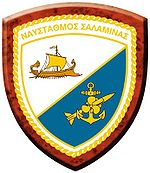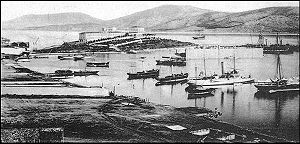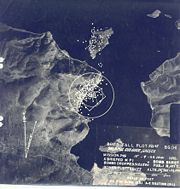
Salamis Naval Base
Encyclopedia

Naval base
A naval base is a military base, where warships and naval ships are deployed when they have no mission at sea or want to restock. Usually ships may also perform some minor repairs. Some naval bases are temporary homes to aircraft that usually stay on the ships but are undergoing maintenance while...
in Greece
Greece
Greece , officially the Hellenic Republic , and historically Hellas or the Republic of Greece in English, is a country in southeastern Europe....
. It is located in the northeastern part of Salamis Island
Salamis Island
Salamis , is the largest Greek island in the Saronic Gulf, about 1 nautical mile off-coast from Piraeus and about 16 km west of Athens. The chief city, Salamina , lies in the west-facing core of the crescent on Salamis Bay, which opens into the Saronic Gulf...
(Cape Arapis) and in Amphiali and Skaramanga. It is close to the major population centres of Athens
Athens
Athens , is the capital and largest city of Greece. Athens dominates the Attica region and is one of the world's oldest cities, as its recorded history spans around 3,400 years. Classical Athens was a powerful city-state...
and Piraeus
Piraeus
Piraeus is a city in the region of Attica, Greece. Piraeus is located within the Athens Urban Area, 12 km southwest from its city center , and lies along the east coast of the Saronic Gulf....
.
Most Hellenic Navy ships are based at Salamis, as well as many of its administrative, training and support services. The Naval Base employs approximately 10,000 naval and civilian personnel.
History

Greek War of Independence
The Greek War of Independence, also known as the Greek Revolution was a successful war of independence waged by the Greek revolutionaries between...
(1821 Revolution) was founded on Hydra Island
Hydra, Saronic Islands
Hydra is one of the Saronic Islands of Greece, located in the Aegean Sea between the Saronic Gulf and the Argolic Gulf. It is separated from the Peloponnese by narrow strip of water...
in 1827 and soon after was relocated to Poros
Poros
Poros is a small Greek island-pair in the southern part of the Saronic Gulf, at a distance about 58 km south from Piraeus and separated from the Peloponnese by a 200-metre wide sea channel, with the town of Galatas on the mainland across the strait. Its surface is about and it has 4,117...
. It remained in use until 1881 and the facility is still used today for naval personnel training.
Between January 1878 and April 1881, certain activities were transferred from Poros to the Faneromeni Monastery (37°59′00"N 23°26′10"E) and its surrounding area, on Salamis Island.
On April 16, 1881, a Royal Decree directed that a new naval base would be built in Salamis, at a location then called Arapi, near Akra (Cape) Arapis. The Navy acquired an area of approximately 300 hectare
Hectare
The hectare is a metric unit of area defined as 10,000 square metres , and primarily used in the measurement of land. In 1795, when the metric system was introduced, the are was defined as being 100 square metres and the hectare was thus 100 ares or 1/100 km2...
s.. Most of the land was donated by the Municipality of Salamis, which saw the construction of the naval base as an opportunity for employment, real estate development and business profit.

Saint Nicholas
Saint Nicholas , also called Nikolaos of Myra, was a historic 4th-century saint and Greek Bishop of Myra . Because of the many miracles attributed to his intercession, he is also known as Nikolaos the Wonderworker...
(1882).
The new Naval Base was used intensively during the Balkan Wars
Balkan Wars
The Balkan Wars were two conflicts that took place in the Balkans in south-eastern Europe in 1912 and 1913.By the early 20th century, Montenegro, Bulgaria, Greece and Serbia, the countries of the Balkan League, had achieved their independence from the Ottoman Empire, but large parts of their ethnic...
, the First World War and the Second World War. A suburban standard gauge light railway line (Piraeus-Perama light railway
Piraeus-Perama light railway
The Piraeus-Perama light railway was a standard gauge suburban light railway line in Greece which connected downtown Piraeus with Perama and Salamis Naval Base...
) opened in 1936, connecting downtown Piraeus with Perama and terminating inside the Naval Base at Amphiali. The line remained in use until 1977.
During the Second World War the naval base was occupied by the Germans and used for naval activities, including submarine operations. The Germans retreated in 1944, after causing extensive damage to the installations. In addition the sea channel was blocked by a number of naval ships sunk by the Luftwaffe in 1941, including the decommissioned battleships Limnos
Greek Battleship Limnos
Limnos, sometimes spelled Lemnos , was a 13,000 ton Mississippi-class Greek battleship named for a crucial naval battle of the First Balkan War.-History of the ship:...
and Kilkis
Greek Battleship Kilkis
Kilkis was a 13,000 ton Mississippi-class battleship originally built by the US Navy in 1904–1908. The Greek Navy purchased the ship in 1914, along with her sister , renamed Limnos. Kilkis was named for the Battle of Kilkis-Lahanas, a crucial engagement of the Second Balkan War...
.
Cleanup, salvage and reconstruction work began in November 1944 and the facilities were gradually restored to operational condition. Salamis Naval Base has been in continuous use by the Hellenic Navy ever since, while a second major naval base was constructed at Souda Bay
Souda Bay
Souda Bay is a bay and natural harbour on the northwest coast of the Greek island of Crete. The bay is about 15 km long and only two to four km wide, and a deep natural harbour. It is formed between the Akrotiri peninsula and Cape Drapano, and runs west to east...
.
Structure and activities
.jpg)
- Ship movements, docks, jetties and base security
- Salamis Naval Hospital (ΝΝΣ)
- General procurement and supplies service (ΝΣ/ΔΕ)
- Fuel supply service (ΝΣ/ΔΚ)
- Naval infrastructure section (ΝΣ/ΔΝΕΡ)
- Naval weapons service (ΝΣ/ΔΝΟ)
- Chemical Laboratory (ΝΣ/ΔΝΧ)
- Financial section (ΝΣ/ΔΟΥ)
- Technical section (ΝΣ/ΔΤ)
The following commands of the Fleet Headquarters are also based within Salamis Naval Base:
- Hellenic Command Frigates
- Hellenic Command Fast Boats
- Hellenic Command Gun Boats
- Hellenic Command Mine Sweepers
- Hellenic Command Amphibious Forces
- Hellenic Command Submarines
- Underwater Demolition Command
Other naval units in the base area include:
- Palaskas Training Camp
- Amphiali Heliport, LGAM
In addition, the Forward Operating Naval Bases of Skyros and Chalkidiki are controlled by Salamis Naval Base.

